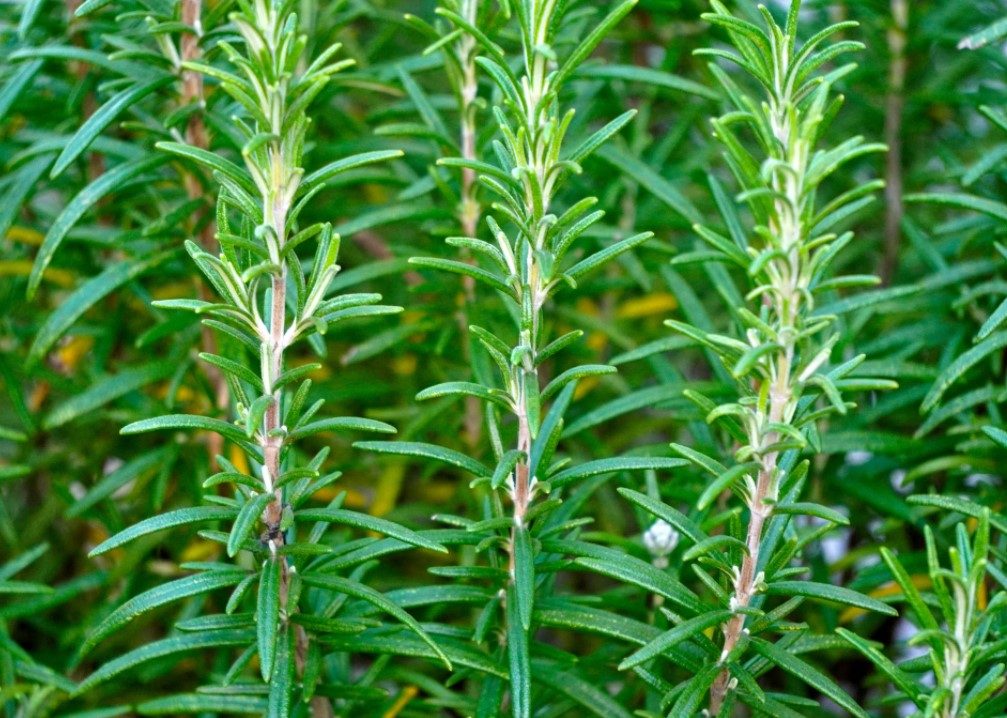Flavorful, fragrant, and easy to plant, who can deny the charm of fresh rosemary? The perennial evergreen blue flower is an aromatic herb with a sweet flavor to it.
For you who wish to grow rosemary within the comfort of your own home, learn everything you need to know about how to grow rosemary from stem cutting.
Since rosemary is pretty versatile, you can even grow it in plants, within plant containers, and move it outside during the peak of summer and chilly winter.
Coming from the shores of the Mediterranean Sea, rosemary (rosmarinus officinalis) is a type of herb that does best in humid areas.
Often used as a seasoning for stews, soups, and poultry, rosemary is best cultivated as a perennial shrub in Zones 8 and warmer, where it can grow as high as 4 feet tall and wide depending on the type and variety.
However, you can also grow it indoors where the weather is colder. The key is to keep it in containers and store it indoors where the sun can reach it to keep it alive.
For some people, rosemary seeds can take too much time to germinate and flourish; hence, they prefer to purchase young plants and cultivate them from young cuttings. Wondering how to grow rosemary from stem cutting? Here’s how you can get the best of rosemary plants!
In this post
Different Ways of Growing Rosemary
(…and why stem cutting is the best method.)
Whether it’s growing a new plant from seeds or purchasing a new plant every year, there are simply many ways to grow rosemary within the comfort of your home. However, both methods also come with their drawbacks.
Purchasing a new plant every year is costly, not to mention that there’s a chance that it’s been infected by disease or pest. Additionally, growing a new rosemary plant from seeds is time-consuming. Surely, you wouldn’t want to wait forever to see it flourish, right?
Growing rosemary from stem cuttings proves to be a solution for this. Here are some of its benefits:
1. Easy and quick to harvest
As you can see, rosemary has a low germination rate and takes a lot of time to sprout and flourish completely. In comparison to growing it from seeds, growing rosemary from stem cuttings is way easier and the plant is faster to mature. This means you can harvest it sooner.
2. Coming from the same mother plant
Have you ever bought a plant, only to realize that it has been contained with disease or pest later? If you’re growing rosemary from stem cuttings, you won’t need to worry about this part. Since the stem comes from the same mother plant, it’ll have the same taste, disease resistance, and growth rate.
3. Cultivate multiple plants at the same time
Another benefit of growing rosemary from stem cuttings: get a lot of rosemary by cutting multiple stems! Not only that it’s cheaper, but you can even create a garden of your own using only one mother plant.
How to Propagate Rosemary from Stem Cutting

Wondering how to grow rosemary from stem cutting? Worry not; here are some foolproof steps to guide you in growing this wonderful herb within the comfort of your home:
1. Carefully select the mother plant
The key step in growing healthy rosemary is during its selection process. When you want to pick a stem, always choose the healthy, young ones that still look fresh. Usually, you’ll be able to spot it by looking for the green-colored stems with flexible stems. On the other hand, always avoid the woody stems with dark brown colors.
2. Snip the stem
After finding the right rosemary stem, cut the rosemary stems using sharp scissors. Never use dull scissors as it’ll damage the stem. Make sure to always cut it about 5 to 6-inches back from the freshly grown tips.
Additionally, you can always cut a lot of extra stems in case it fails to grow roots and you need to plant new rosemary.
3. Remove the lower leaves
Once you’ve snipped the stem, you need to completely strip off the lower leaves of rosemary. Put your fingers around it and gently pinch the lower 2-inches needles from the stem.
4. Put the end in the water
The key next step is to put the end of your rosemary in the water so that it won’t die out of thirst. Place the stems in a jar of water and position it within the reach of warm sunlight, but not directly under it. Make sure to change the water daily so that it stays fresh.
After putting the stems in water, you can expect them to grow roots after 4 to 6 weeks, depending on the temperature. Colder zones tend to take longer. However, if the cuttings don’t survive, they’ll turn brownish in color and shed needles.
5. Move to soil
If your rosemary cuttings survived the previous steps, congratulations, now they’re ready to be potted into soil!
Usually, it’s ready to be moved when there are 4 until 6 roots with ½-inch long for each. Prepare soil that consists of a sandy soil mix for good drainage. You can also use cactus soil. During the planting process, be aware not to damage the roots. Afterward, place it under indirect sunlight at a humid temperature and water it regularly.
Wondering when you can start harvesting your rosemary? Be patient, because you’ll need to wait for it!
However, you can start harvesting it once it grows into 6-inches tall and grows more leaves. Harvest your rosemary by cutting the stems as needed, but don’t cut too much because rosemary has a slow growth rate, and you won’t want it to look bald due to over-harvest.
How to Take Care of Rosemary Plants
While rosemary has a lot of benefits and advantages, it’s also a plant that needs constant care and grooming. Now that you know how to grow rosemary from stem cuttings, now it’s time to figure out how to take care of them so it’ll continue to be healthy and cheer up your home.
- Provide enough humidity and sunlight for your rosemary plants. Avoid dark or overly cold spots.
- Despite liking to stay on the dry side, always make sure that your rosemary plant isn’t dehydrated. Water the pot when the soil feels dry.
- Rosemary plant will continue to grow bigger, so you need to re-pot it into a bigger container once it grows into 1 to 3 feet high.
- Always prune frequently to ensure its robust growth! Pruning your rosemary also will make it look neater and more beautiful in the eye.
How to Take Care of Rosemary During Winter
- Before fully taking your plant inside during winter, always quarantine it first to be sure that there are no pests or diseases.
- Although it’s winter, make sure to locate the rosemary in a bright, sun-filled window to keep them growing.
- Keep the soil moist. Over-watering will lead to rotting, while dehydration will make the plant wither and die.
- Do a temperature check regularly; rosemary grows best in 60 until 65 degrees.
- Humidity is good for rosemary. Compensate the dry winter air by running a humidifier.
- Rosemary is prone to indoor pests and diseases such as aphids, red spider mites, and whiteflies. To avoid it, do pest control using insecticidal soap and do a regular check on the air and water circulation.
Rosemary Planting Companion
Some people dislike it when their plants are lonely. You might wonder, “what plants could grow well with rosemary?”. Let’s find out the perfect companion for your rosemary plant!
- Brassicas or cabbage family plants, such as cabbage, broccoli, radishes, kohlrabi, cauliflower, and kale.
Beans. Rosemary provides a fresh smell to keep them safe from beetles. - Carrots. Rosemary can mask the smell of carrots to avoid pests from laying eggs on them.
- Sage. Planting rosemary nearby enhances its smell and flavor.
- Parsnips. Similar to carrots, parsnips may benefit from rosemary smell.
How to Harvest Rosemary Plants
Wondering how to harvest rosemary without killing the plant? Here’s a foolproof step for it.
- Cut off the stems, and you can use them fresh. Or, you can hang the cut stems to dry.
- Like many other herbs, rosemary cannot stay outdoor during winter. So, bring the potted plants inside. Learn how to overwinter rosemary indoors.
- Snip off young stems and leaves for a fresh taste.
- Take no more than a third of the rosemary at any one time. Allow the plant to replace its growth before taking more.
How to Store Rosemary
- Air-dry your freshly harvested rosemary and store it in an airtight container.
- Store your rosemary in a Ziploc bag and put it in the refrigerator.
- Dry your rosemary by placing it on parchment paper and set the oven on the lowest setting.
- Infusing vinegar or olive oil with rosemary.
Some Questions about Growing Rosemary
When is the best time to plant rosemary?
Rosemary is best planted in spring or autumn when the temperature is warm, and the soil is humid.
Where does rosemary grow best?
Most rosemary varieties will grow best on zones 8 and warmer where it gets full sun, and the best soil pH is 6.0 – 7.0.
How often should rosemary be watered?
Water rosemary every 1 to 2 weeks. Better check the soil and make sure the plants dry out thoroughly between each watering.
Can you revive dead rosemary?
If the rosemary stem is still alive, you can revive it by pruning the leaves and removing the dead branches.


